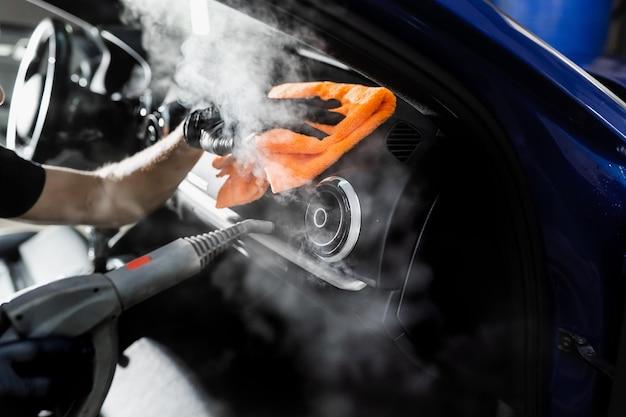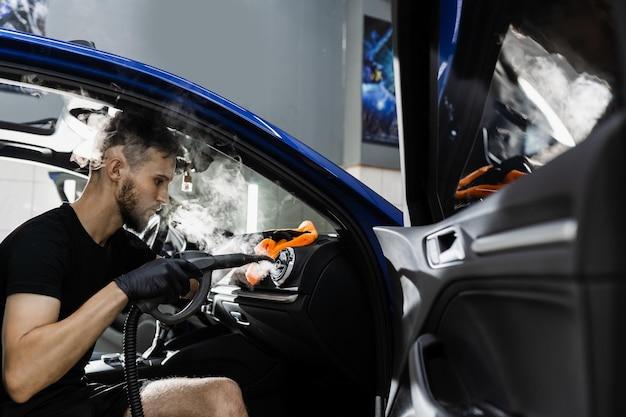Welcome to our comprehensive guide on removing sticky residue from your car dashboard! If you’ve ever experienced the frustration of clutching your steering wheel and feeling a not-so-pleasant stickiness under your fingers, you’re not alone. It’s a common problem that many car owners face, especially if their vehicle has been exposed to high temperatures or spills. But fear not, because in this article, we’ll share some effective methods and tips to help you restore your dashboard to its clean and smooth glory.
We’ll address common questions like “Does WD-40 remove sticky residue?” and “How do you remove sticky residue from a dashboard?” We’ll also explore the causes of a sticky dashboard and delve into alternative household products that can be used as cleaning solutions. So, get ready to say goodbye to sticky frustrations and hello to a fresh and sparkling dashboard. Let’s dive in and discover how to make your car’s interior shine!
How to Remove Sticky Residue from Your Car Dashboard
You know that feeling when you finally get into your car after a long day at work, ready to hit the road and leave your worries behind? But then, as you reach out to adjust the volume on your radio or turn on the air conditioning, your fingers stick to a stubborn, gooey mess on your car dashboard. Ugh! Sticky residue can be a real annoyance, and who wants to drive around with a dashboard that feels like it’s covered in old bubblegum? Not me, and probably not you either! Luckily, I’ve got you covered with some top-notch tips on how to banish that sticky residue from your car dashboard for good!
Assess the Situation
Before jumping right in and attacking the sticky mess, it’s important to assess the situation. Take a careful look at your car dashboard and identify the type of material it’s made of. Is it plastic, leather, vinyl, or something else? This information will help you choose the most appropriate method for removing the residue without causing any damage.
Gather Your Tools
Alright, now that you know what you’re dealing with, it’s time to gather your tools. Here’s a list of items you’ll need to have on hand:
- Rubbing alcohol: This will be your trusty sidekick in the battle against sticky residue. It works wonders at breaking down the stickiness and removing it from your dashboard.
- Microfiber cloth: A soft and gentle cloth is your best friend when it comes to cleaning your car dashboard. It won’t scratch the surface and will help you achieve a streak-free finish.
- Cotton swabs: These little guys are perfect for getting into tight spots and crevices where sticky residue may be hiding.
- Plastic scraper: If the residue is particularly stubborn, a plastic scraper can come to the rescue. Be careful not to use anything metal that could scratch the dashboard.
- Baking soda: This versatile ingredient can be used as a natural cleaner and deodorizer, making it a great addition to your sticky residue removal arsenal.
Method 1: Rubbing Alcohol Magic
Grab your trusty microfiber cloth and moisten it with some rubbing alcohol. Gently dab the cloth onto the sticky residue, allowing the alcohol to work its magic. Don’t rub too vigorously, as that could cause damage to the dashboard. Instead, take your time and have a little chat with your dashboard while the rubbing alcohol does its job. Once the residue starts to dissolve, wipe it away with the cloth. Repeat this process until your dashboard is completely free of stickiness.
Method 2: Cotton Swab Precision
For those hard-to-reach spots or smaller areas of sticky residue, cotton swabs are your secret weapon. Dip a cotton swab into some rubbing alcohol and carefully apply it to the sticky residue, focusing on one small area at a time. The precision of the cotton swab will ensure that you don’t spread the stickiness around. Once the residue has been lifted, wipe the area clean with your microfiber cloth. You’ll be amazed at how those little swabs can work wonders!
Method 3: Baking Soda Sorcery
Ah, baking soda, the unsung hero of cleaning! Create a paste by mixing baking soda with a small amount of water. Apply the paste onto the sticky residue and gently scrub it in using a soft cloth. The baking soda will help break down the residue and leave your dashboard looking and feeling fresh. Once you’ve worked your magic with the paste, wipe away the residue with a damp cloth. Ta-da!
Final Thoughts
Say goodbye to sticky residue and hello to a clean, smooth dashboard that’s ready to take you on your next adventure! Remember to always test any cleaning method in a small, inconspicuous area before applying it to the entire dashboard. And in case you find yourself facing sticky residue again in the future, now you know exactly how to handle it like a pro. Safe travels, my friend, and may your dashboard always remain stick-free!
*Disclaimer: This article is for informational purposes only. Always follow manufacturer guidelines and test cleaning methods in small areas before applying them to larger surfaces.
FAQ: How To Remove Sticky Residue From Car Dashboard
Does WD-40 Remove sticky residue
WD-40 is a popular household product often used to lubricate, clean, and protect various surfaces. When it comes to removing sticky residue from a car dashboard, WD-40 can be quite effective. Its powerful formula helps to break down adhesives, making it easier to remove sticky substances. Just spray a small amount of WD-40 onto a cloth and gently rub the sticky residue. However, remember to clean the dashboard thoroughly afterward to remove any WD-40 residue.
How do you remove sticky residue from the dashboard
Removing sticky residue from a car dashboard can be a frustrating task, but fear not! Here’s a simple and effective method:
- Start by using a soft cloth dampened with warm, soapy water.
- Gently scrub the sticky area using circular motions to loosen the residue.
- For tougher residue, you can try using rubbing alcohol or a specifically designed adhesive remover.
- After applying the solvent, let it sit for a few minutes to allow it to break down the stickiness.
- Take a clean cloth and wipe away the residue, repeating the process if necessary.
- Finally, make sure to thoroughly clean the area with water and mild soap to remove any leftover residue or cleaning product.
Remember, it’s important to test any cleaning products on a small, inconspicuous area first to avoid damaging the dashboard.
What causes a dashboard to get sticky
Sticky dashboards can be a common annoyance, especially in warmer climates. The stickiness is often caused by several factors, including:
- Sunlight and heat: Prolonged exposure to sunlight and high temperatures can cause materials to deteriorate, leading to stickiness.
- Chemical reactions: Certain chemicals, such as plasticizers or adhesives used in the manufacturing process, can break down over time and create a sticky residue.
- Dust and dirt: Dust particles can accumulate on the dashboard’s surface, mixing with moisture and creating stickiness.
To prevent a sticky dashboard, it’s a good idea to regularly clean and protect your dashboard using suitable products.
Does vinegar remove adhesive
Yes, vinegar can be an effective and natural solution for removing adhesive residue. Its acidic properties help to break down sticky substances. To use vinegar to remove adhesive from your car’s dashboard:
- Mix equal parts white vinegar and warm water in a spray bottle.
- Spray the solution onto the sticky residue.
- Allow it to sit for a few minutes to penetrate the adhesive.
- Gently scrub the area with a soft cloth or sponge until the residue is removed.
- Rinse the dashboard with clean water and dry it thoroughly.
Vinegar is a versatile and affordable household item that can work wonders in removing sticky residue.
What is the best Sticky Stuff Remover
While there are many sticky stuff removers available on the market, it ultimately depends on the type of residue you’re dealing with. Some popular and effective sticky stuff removers to consider include:
- Goo Gone: A well-known adhesive remover that works on various surfaces, including car dashboards.
- Rubbing alcohol: Great for removing stubborn adhesives and can be found in most households.
- WD-40: Widely used to remove sticky residue, though it’s important to clean the area thoroughly afterward.
- Isopropyl alcohol: Another common household item that works well on many types of adhesives.
- Mineral spirits: Often used to remove sticky or gummy substances, although it’s advisable to test it on a small area first.
It’s always a good idea to follow the instructions on the product labels and test any sticky stuff remover on a small, inconspicuous area before applying it to the whole dashboard.
Can you use Goo Gone on car interior
Yes, Goo Gone can typically be used on car interiors, including the dashboard. It effectively removes adhesive residue, stickers, gum, tar, crayon marks, and more. However, before using it on delicate surfaces like leather, vinyl, or plastic, it’s essential to test Goo Gone on a small, inconspicuous area to ensure it doesn’t cause any damage or discoloration. Additionally, always follow the instructions provided by the manufacturer when using any cleaning product on your car’s interior.
Does WD-40 damage car paint
WD-40 is generally considered safe on car paint. Its formula is designed to be lubricating and protective, rather than damaging. However, it’s important to use WD-40 cautiously and avoid prolonged exposure or excessive use on car paint. If sprayed directly onto the paint, it’s advisable to wipe it off promptly and wash the area with mild soap and water to remove any residue. To be extra cautious, you can also wax the affected area after removing the sticky residue.
What do car detailers use to clean the dashboard
Professional car detailers have their arsenal of tricks and preferred products for cleaning dashboards. Some common tools and products they often use include:
- Soft-bristled brushes: Ideal for dusting and cleaning hard-to-reach areas.
- Microfiber cloths: Gentle and effective for wiping dust and removing smudges without scratching the dashboard.
- Dash cleaning products: Detailers often use specialized dashboard cleaners that are safe for various surfaces, leaving a streak-free and glossy finish.
- Compressed air: Used to blow away dust and debris from crevices and vents.
- Detailing clay: Helps to remove embedded contaminants from the dashboard’s surface.
It’s worth noting that professional detailers have extensive experience and knowledge, making their techniques and products yield excellent results.

